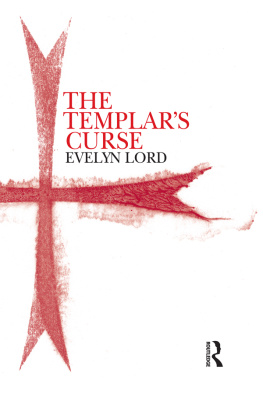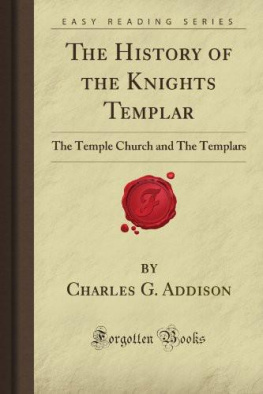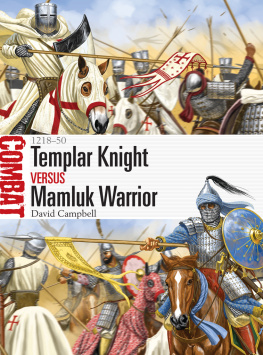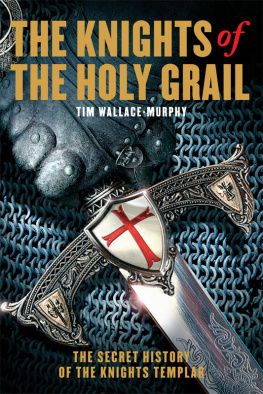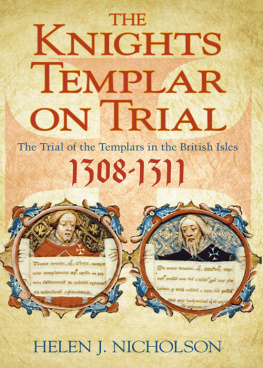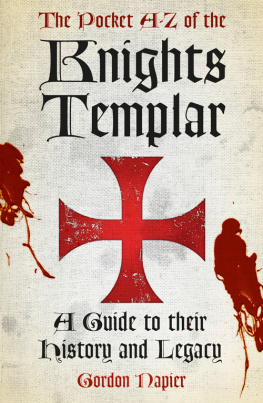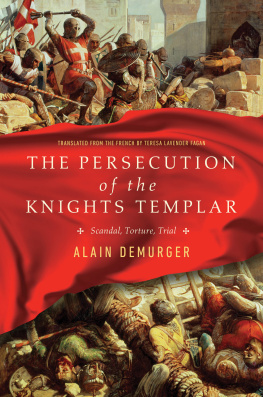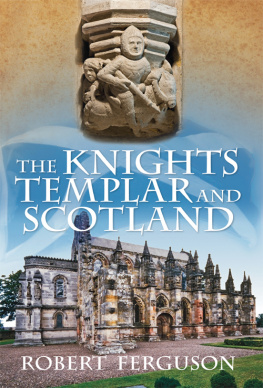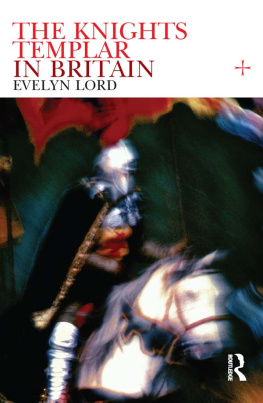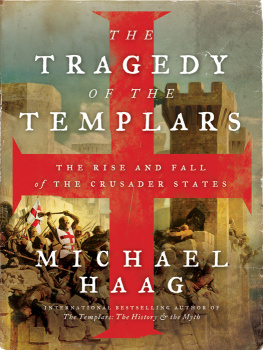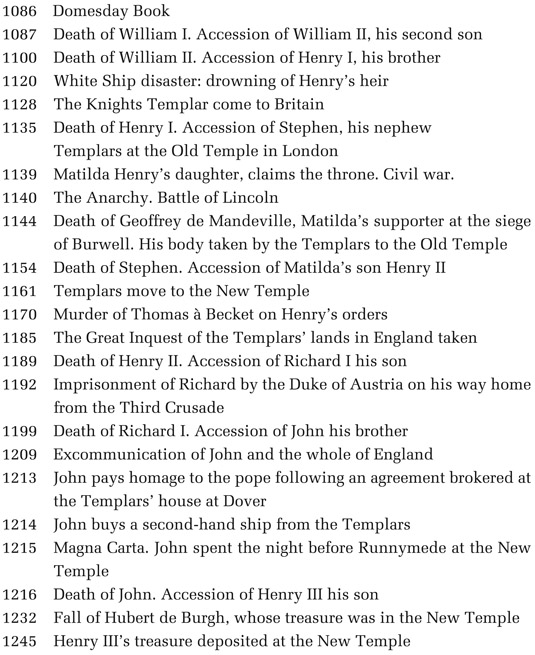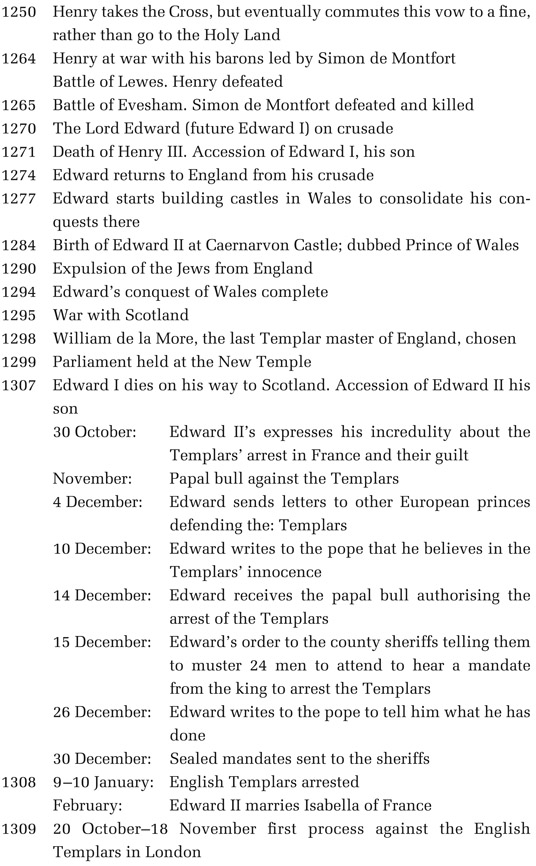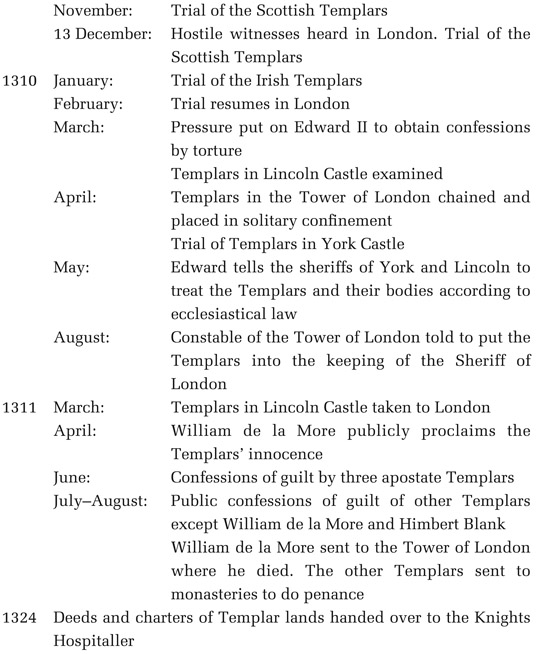I n 1099 the First Crusade took Jerusalem for the Christians. This unleashed a flood of pilgrims hastening to the Holy City and the places described in the New Testament in order to gain redemption from their sins. These innocent and unprepared travellers became a prey for robbers, Saracens and wild animals. They died in their hundreds as they tried to retrace the steps of Christ from Jerusalem to the River Jordan, the desert and the Sea of Galilee.
In Jerusalem at this time were a group of French knights, led by Hugh de Payens. They may have been part of the First Crusade, or have come to the Holy Land as pilgrims themselves. How or why they were in Jerusalem is not known. Nor is the date when they founded their order of monkish knights. Was it as a response to the slaughter of 300 pilgrims at Easter 1119? Or was it earlier than this? William, Archbishop of Tyre, writing after the event, suggests that the Order was founded in 1118 when certain pious and God-fearing nobles of knightly rank devoted to the Lord, professed the wish to live perpetually in poverty, chastity and obedience. In the hands of the Patriarch they vowed themselves to the service of God as regular canons. At this point they had taken religious vows, but as yet were not a military order. Tyre continues.
Foremost and most distinguished among these men were the venerable Hugh de Payens and Godfrey de St Omer. Since they had neither church, nor a fixed place of abode the king granted them a temporary dwelling place in his own palace, on the north side of the Temple of the Lord The main duty of this order that which was enjoined upon them by the
The story of the Orders foundation was embroidered by Walter Map, who was a clerk in the household of Henry II, king of England in the 1170s. He attributed the foundation of the Order entirely to the bravery of Hugh de Payens who single-handedly fought off the Saracens who attacked pilgrims that came to drink at the Red Pool. Word of de Payenss deeds came to the regular canons of Jerusalem who gave him a large hall in the Temple of Solomon, where he was joined by his knightly companions.
Hugh de Payens and the Temple of Solomon
Like so many aspects of the Knights Templar much of the detail surrounding their foundation is shrouded in mystery. We know that it was founded by Hugh de Payens, who became the Orders first Grand Master. Hugh de Payens may have come from a village of that name in Champagne, and his overlord the Count of Champagne may have played an important part in the subsequent course of the Order, as he was an intimate of St Bernard of Clairvaux, the Templars patron.
The original members of the Order (see They were known collectively as brothers and when not in the saddle they lived a cloistered life dedicated to the worship of God.
The Orders first dwelling place was in the Temple of Solomon and there is proof of this not only from tradition, but also from the evidence of a German monk Theoderic, who visited Jerusalem in 1174 and left a description of the knights precinct in the Temple of Solomon. They may have been given these premises by King Baldwin of Jerusalem as William of Tyre suggested, or by the patriarch of Jerusalem or the canons of the Holy Sepulchre.
Founder knights of the Knights templar
Hugh de Payens, First Grand Master
Andrea de Montbord
Archimbaud de St Armand from Picardy
Geoffroy Bisol or Bisot
Godfrey de St Omer from Picardy
Payen de Montdidier from Picardy
Roland or Rossol
Although the Orders original aim was to protect pilgrims, this was a body of knights trained in arms and warfare and possessing a great deal of aggressive energy. If this could be harnessed into fighting for God and the Christian occupation of the Holy Land, they believed they would gain absolution for their sins through the practical application of the life they knew best combat and would be doing the whole of Christendom an inestimable service.
It soon became clear that a handful of knights would not succeed in stemming the flow of the enemies of Christ into the Holy Land. Men, money and resources were needed. In order to acquire these, the western powers had to be wooed into recognizing the Order and sponsoring it by granting it resources. In 1127 Hugh and five companions left the East for the Council of Troyes in France to put the case for the Order, and to establish it firmly in western minds by promoting the idea that a man dedicated by his vows to the service of God could spill blood provided it was not Christian blood.
Hugh put his case to the Council of Troyes on 13 January 1129. He already had an advocate at the council, St Bernard of Clairvaux, who had been alerted to Hughs presence at the council by the Count of Champagne. Bernard was the energetic and articulate young nobleman who became abbot of Clairvaux, daughter house of Citeaux, the first monastery of the reforming Cistercian order. Bernard and Hugh came from the same background and understood each other.
It was Bernard who had given the Cistercians their identity as a separate order, and had drawn up the strict guidelines by which they were
The Templar Rule
The Rule drawn up at the Council of Troyes for the Templars starts by describing how Hugh came to the Council and told them about his order of monkish knights. Those who heard him are listed, and the preamble states that the rules were approved by the pope and the patriarch of Jerusalem. The rules go into every detail of the Orders life. They describe who could join the Order: this was limited to freemen and adult males; no serfs or women were allowed to join the Templars, but married men could enrol provided that their wives were either dead or in a nunnery, or they could become associate members for a specific time. From the start the Order was designed for the elite members of society, and was to be a totally male institution.
The Rule describes how the reception of those joining the Order should take place. At the reception the initiate was to declare that he was a freeman in good health, and had no outstanding debts. He asked to be a knight of Christ in holy orders and would renounce his own free will. Once he had been accepted by those present the Templar Rule was explained to him and he knelt with both hands on the Gospels and promised his life to God and the Blessed Virgin. He vowed to be chaste, to live a life of poverty and to be obedient to God and the Order. The Templar mantle was placed around his neck, and the chaplain and whoever was conducting the reception would raise him up and kiss him on the mouth. This reception format was open to misinterpretation, and it became one of the chief planks in the case against the Templars.
The Rule showed how life in the cloister and on campaign was to be governed. In the cloister the Templars were to live a monastic life, attending the daily offices and observing absolute silence. Discipline in the cloister was to be maintained through chapter meetings where brothers could either confess their errors, or be accused by others. They were then punished and absolved. This too became open to misinterpretation.
Brothers could be expelled from the Order for revealing its secrets, for simony (buying preferment), for killing a Christian, for theft, for desertion in the time of battle, for desertion to the enemy, and for sodomy. Lesser crimes for which the brother lost the Templar habit for a time, was put in irons and treated like a dog, including being made to eat his food of the floor included disobedience, striking another brother, contact with a woman, and charging into battle without permission. These statutes were to have repercussions later as well. When on campaign the Templars had to say paternosters whilst in the saddle.

